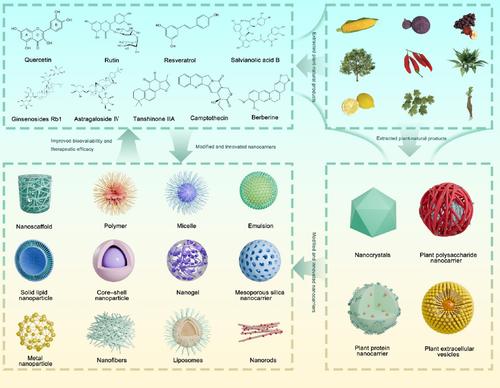The development of nanocarriers for natural products.
IF 8.2
Wiley interdisciplinary reviews. Nanomedicine and nanobiotechnology
Pub Date : 2024-05-01
DOI:10.1002/wnan.1967
引用次数: 0
Abstract
Natural bioactive compounds from plants exhibit substantial pharmacological potency and therapeutic value. However, the development of most plant bioactive compounds is hindered by low solubility and instability. Conventional pharmaceutical forms, such as tablets and capsules, only partially overcome these limitations, restricting their efficacy. With the recent development of nanotechnology, nanocarriers can enhance the bioavailability, stability, and precise intracellular transport of plant bioactive compounds. Researchers are increasingly integrating nanocarrier-based drug delivery systems (NDDS) into the development of natural plant compounds with significant success. Moreover, natural products benefit from nanotechnological enhancement and contribute to the innovation and optimization of nanocarriers via self-assembly, grafting modifications, and biomimetic designs. This review aims to elucidate the collaborative and reciprocal advancement achieved by integrating nanocarriers with botanical products, such as bioactive compounds, polysaccharides, proteins, and extracellular vesicles. This review underscores the salient challenges in nanomedicine, encompassing long-term safety evaluations of nanomedicine formulations, precise targeting mechanisms, biodistribution complexities, and hurdles in clinical translation. Further, this study provides new perspectives to leverage nanotechnology in promoting the development and optimization of natural plant products for nanomedical applications and guiding the progression of NDDS toward enhanced efficiency, precision, and safety. This article is categorized under: Therapeutic Approaches and Drug Discovery > Emerging Technologies Nanotechnology Approaches to Biology > Nanoscale Systems in Biology.

天然产品纳米载体的开发。
来自植物的天然生物活性化合物具有巨大的药理作用和治疗价值。然而,大多数植物生物活性化合物的开发都受到低溶解度和不稳定性的阻碍。片剂和胶囊等传统制药形式只能部分克服这些局限性,从而限制了其药效。随着近年来纳米技术的发展,纳米载体可以提高植物生物活性化合物的生物利用度、稳定性和精确的细胞内转运。研究人员正越来越多地将基于纳米载体的给药系统(NDDS)整合到天然植物化合物的开发中,并取得了巨大成功。此外,天然产品受益于纳米技术的提升,并通过自组装、接枝修饰和仿生设计促进了纳米载体的创新和优化。本综述旨在阐明纳米载体与植物产品(如生物活性化合物、多糖、蛋白质和细胞外囊泡)相结合所实现的合作与互惠进展。本综述强调了纳米医学面临的突出挑战,包括纳米药物制剂的长期安全性评估、精确靶向机制、生物分布的复杂性以及临床转化的障碍。此外,本研究还为利用纳米技术促进天然植物产品在纳米医学应用中的开发和优化,以及指导 NDDS 向更高效、更精确和更安全的方向发展提供了新的视角。本文归类于治疗方法与药物发现 > 新兴技术 纳米生物学方法 > 生物学中的纳米尺度系统。
本文章由计算机程序翻译,如有差异,请以英文原文为准。
求助全文
约1分钟内获得全文
求助全文
来源期刊
CiteScore
17.60
自引率
0.00%
发文量
0

 求助内容:
求助内容: 应助结果提醒方式:
应助结果提醒方式:


